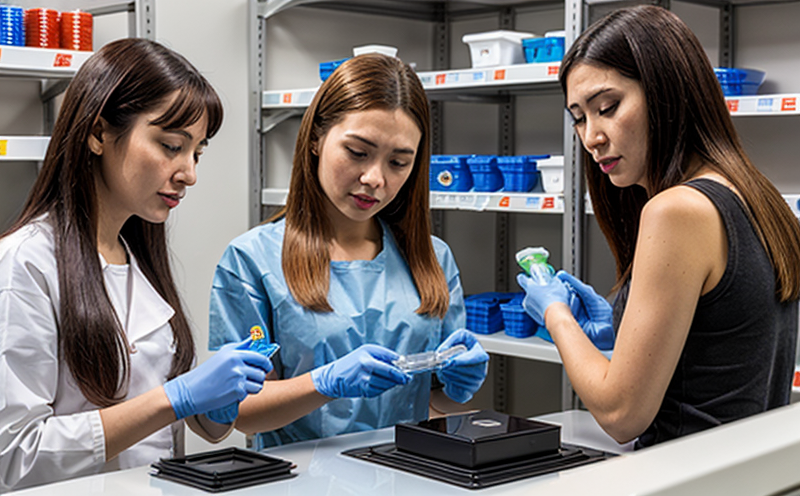NF EN 1186 Overall Migration Testing of Food Contact Consumer Plastics
The NF EN 1186 standard is a European harmonized standard that provides a framework for assessing the overall migration of substances from food contact consumer plastics into foods. This testing method ensures compliance with European Union regulations to protect public health and safety.
Overall migration testing evaluates the release of chemical substances, including monomers, oligomers, additives, and other compounds, which may migrate from plastic packaging or containers into food products. The standard is particularly important for ensuring that food contact articles do not contain harmful levels of these substances when they come into direct contact with food.
The testing procedure involves exposing the specimen to a defined food simulant under specified conditions, such as temperature and time, which simulate real-world usage scenarios. After exposure, the sample is analyzed using various analytical techniques to measure the amount of migration into the food simulants. The results are then compared against the maximum permitted levels set by the standard.
Compliance with NF EN 1186 ensures that products meet regulatory requirements and provide a safe and reliable option for consumers. This testing is critical in ensuring that packaging does not leach harmful substances into food, thereby protecting public health and safety.
The methodology involves several key steps:
- Sample preparation: The specimen must be cut to the appropriate dimensions as specified by the standard.
- Exposure conditions: Specimens are exposed to a defined food simulant under controlled temperature and time conditions.
- Analytical methods: After exposure, the specimens are analyzed using analytical techniques such as gas chromatography-mass spectrometry (GC-MS) or liquid chromatography-tandem mass spectrometry (LC-MS/MS).
- Result interpretation: The migration levels are compared against the maximum permitted limits set by NF EN 1186.
Compliance with this standard is essential for manufacturers and suppliers of food contact plastics, as it ensures that their products meet regulatory requirements and provide a safe option for consumers. This testing is critical in ensuring that packaging does not leach harmful substances into food, thereby protecting public health and safety.
The NF EN 1186 test focuses on the overall migration from all parts of the plastic article, including the surface layers and any internal structure. The standard provides a framework for assessing the potential risk of migration into foodstuffs, which is crucial in ensuring that consumer products are safe to use.
Scope and Methodology
The scope of NF EN 1186 covers all types of plastics used in packaging or containers intended for direct contact with food. It includes but is not limited to polyethylene, polystyrene, polypropylene, polyvinyl chloride (PVC), and other thermoplastics that come into contact with food.
The methodology involves exposing the specimen to a defined food simulant under specified conditions, such as temperature and time, which simulate real-world usage scenarios. After exposure, the sample is analyzed using various analytical techniques to measure the amount of migration into the food simulants. The results are then compared against the maximum permitted levels set by the standard.
The test procedure includes several key steps:
- Sample preparation: The specimen must be cut to the appropriate dimensions as specified by the standard.
- Exposure conditions: Specimens are exposed to a defined food simulant under controlled temperature and time conditions.
- Analytical methods: After exposure, the specimens are analyzed using analytical techniques such as gas chromatography-mass spectrometry (GC-MS) or liquid chromatography-tandem mass spectrometry (LC-MS/MS).
- Result interpretation: The migration levels are compared against the maximum permitted limits set by NF EN 1186.
The test procedure is designed to ensure that all parts of the plastic article, including surface layers and any internal structure, contribute equally to the overall migration. This approach ensures a comprehensive assessment of potential risks associated with food contact plastics.
Industry Applications
- Packaging: NF EN 1186 is widely used in the packaging industry for testing plastic containers and bottles that come into direct contact with food.
- Beverage Industry: Beverage manufacturers use this standard to ensure their bottles, cans, and other packaging materials are safe for consumer use.
- Food Manufacturing: Food manufacturers rely on NF EN 1186 to test the safety of plastic containers used in the production and storage of food products.
- Hospitality: Hotels and restaurants often use this standard to ensure that their packaging and containers meet regulatory requirements for direct food contact.
The standard is essential for ensuring that all types of plastics used in packaging or containers intended for direct contact with food comply with European Union regulations. Compliance with NF EN 1186 ensures that products are safe and reliable options for consumers, protecting public health and safety.
International Acceptance and Recognition
NF EN 1186 is widely recognized and accepted in Europe as a harmonized standard. Its acceptance extends beyond national borders within the EU to other regions that adopt similar regulatory frameworks for food contact plastics.
- The United Kingdom: Although not part of the EU, the UK has adopted NF EN 1186 into its national standards and regulations.
- Switzerland: This standard is also recognized in Switzerland as a harmonized method for assessing migration from plastic articles to foodstuffs.
- Australia/New Zealand: These regions have adapted their own standards based on NF EN 1186, ensuring that imported products meet local safety requirements.
The widespread adoption and acceptance of NF EN 1186 reflect its importance in ensuring the safety of plastic articles used for food contact. Compliance with this standard is a key factor in maintaining international trade relationships and ensuring product safety across different markets.





